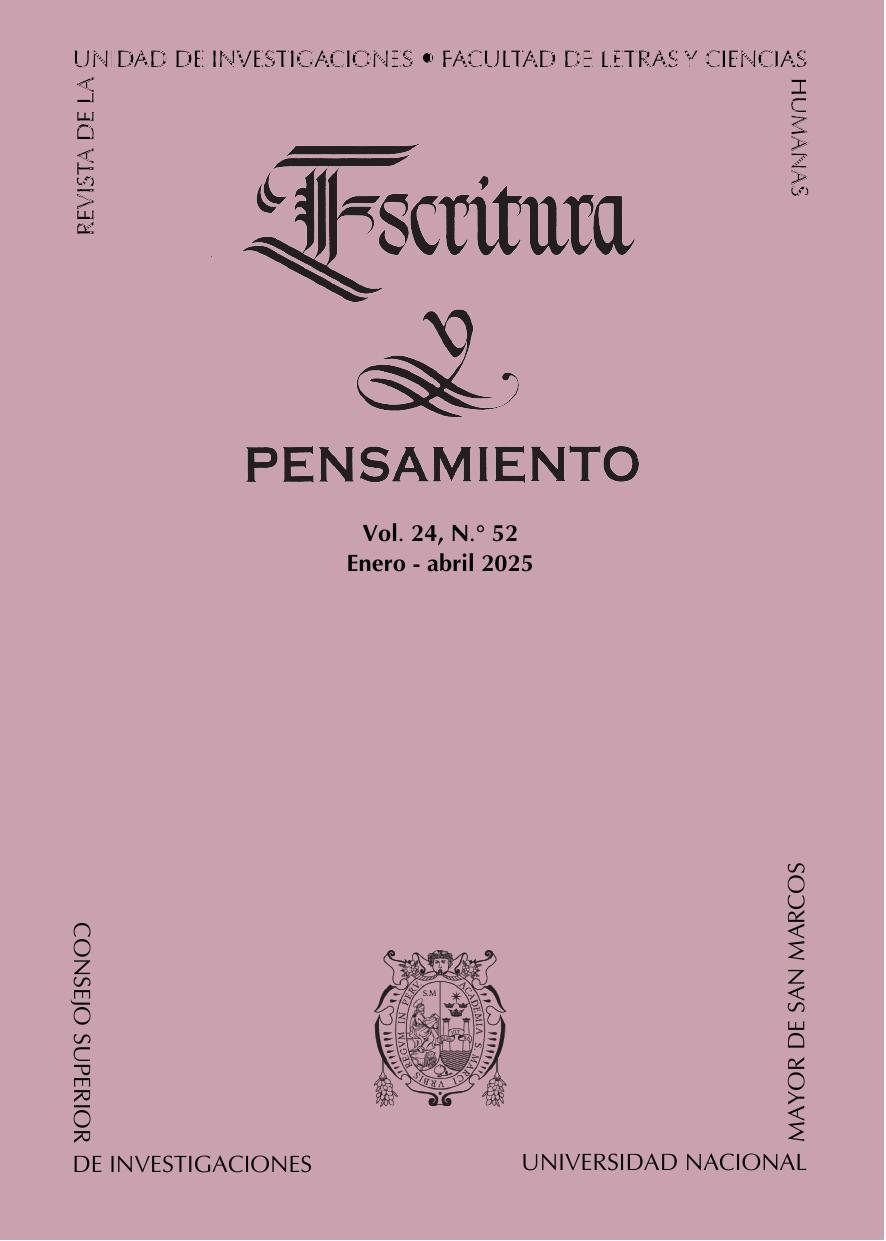Body and animality in “El niño del carrizo” by César Vallejo
DOI:
https://doi.org/10.15381/escrypensam.v24i52.30253Keywords:
body, animality, Peruvian literature, César Vallejo, narrativeAbstract
This article analyzes the tale “El niño del carrizo” by César Vallejo to show that the presence of the animal component allows us to criticize frontally that dualistic position that has taken the right to tell us how we should conceive and feel the world. First, we make a brief introduction in order to underline that this story, although the author did not publish it while he was alive, was written in the heat of his avant-garde production. Secondly, we explain three theoretical notions that will serve us for the analysis: metonymy, from the approaches of Giovanni Bottiroli; body, according to the postulates that Gilles Deleuze takes from Baruch Spinoza; and animality, starting from what Felice Cimatti outlines. Thirdly, we will approach the tale from a succinct critical reception and in dialogue with the theoretical section. In this way, it is concluded that the animal, in “El niño del carrizo”, implies a questioning against the hegemonic and dualistic Western thought.
References
Araníbar, M. L. (1993). Bestiario de Poemas humanos (Tesis de licenciatura, Pontificia Universidad Católica del Perú).
Bottiroli, G. (1993). Retorica. L’intelligenza figuralle nell’arte e nella filosofia. Bollati Boringhieri.
Cimatti, F. (2018). La vita estrinseca. Dopo il linguaggio. Orthotes.
Cimatti, F. (2021). Filosofía de la animalidad. Tercero Incluido.
Cimatti, F. (2022). Assembramenti. Orthotes.
Coccia, E. (2011). La vida sensible. Marea.
Coccia, E. (2022). La vita delle piante. Metafisica della mescolanza. Il Mulino.
Chocano, J. S. (1910). Poesías completas. Casa Editorial Maucci.
Deleuze, G. (1975). ¿Qué es lo que puede un cuerpo? En Spinoza y el problema de la expresión (pp. 208-225). Muchnik Editores.
Deleuze, G. (2008). En medio de Spinoza. Cactus.
Di Benedetto, M. (2018). Estéticas del montaje. Representaciones de lo andino en la narrativa de vanguardia peruana de los veinte. (Tesis de doctorado, Universidad Nacional de La Plata). https://sedici.unlp.edu.ar/handle/10915/71474
González Montes, A. (1993). La narrativa de César Vallejo. En R. González Vigil (Ed.), Intensidad y altura de César Vallejo (pp. 221-263). Pontificia Universidad Católica del Perú.
González Montes, A. (2002). Escalas hacia la modernización narrativa. Fondo Editorial de la Universidad Nacional Mayor de San Marcos.
González Montes, A. (2014). Introducción a la narrativa de Vallejo. Academia Peruana de la Lengua, Universidad Ricardo Palma; Cátedra Vallejo.
González Vigil, R. (2013). Prólogo. En César Vallejo. Narrativa completa (pp. 7-51). Ediciones Copé.
Guichot-Muñoz, E. (2015). Didáctica de lo humano en “Viaje al porvenir” y “El niño del carrizo” de César Vallejo. Jangwa Pana, 14, 125-135. https://idus.us.es/server/api/core/bitstreams/28b737ca-370d-4785-88a9-79ab96476518/content
Gutiérrez, M. (2004). Vallejo, narrador. Fondo Editorial del Pedagó- gico de San Marcos.
Henry, M. (2018). Encarnación. Una filosofía de la carne. Ediciones Sígueme.
Irigaray, L. (2009). Ese sexo que no es uno. Ediciones Akal.
Jakobson, R. y Halle, M. (1980). Fundamentos del lenguaje. Editorial Ayuso.
Lestel, D. (2022). Nosotros somos los otros animales. Fondo de Cultura Económica.
López Nuñez, C. A. (2018). Sobre el concepto de animal en El pez de oro de Gamaliel Churata. Entre Caníbales, 2(9), 185-203.
Luján Sandoval, S. (2023). Lo animal en “Muro noroeste” y “Los caynas” de César Vallejo. Archivo Vallejo, 6(12), 173-203. https://doi.org/10.59885/archivoVallejo.2023.v6n12.09
Mercado, G. (1928). Un chullo de poemas. Editorial Kuntur.
Millares, S. (Ed.) (2013). Del simbolismo al surrealismo: las prosas de las vanguardias hispánicas. Prosas hispánicas de vanguardia (pp. 13-147). Ediciones Cátedra.
Moncloa, F. (1968). Noticia. En César Vallejo. Obras completas (p. 9). Ediciones Copé.
Neale-Silva, E. (1987). César Vallejo, cuentista. Escrutinio de un múltiple intento de innovación. Salvat.
Spinoza, B. (1987). Ética demostrada según el orden geométrico. Alianza Editorial.
Vallejo, C. (1968). El niño del carrizo. En Novelas y cuentos completos (pp. 307-310). Francisco Moncloa Editores S. A.
Vallejo, C. (2013). El niño del carrizo. En César Vallejo. Obras completas (pp. 403-405). Ediciones Copé.
Villafán, M. (2019). Cosmovisión andina en “El niño del carrizo”, de César Vallejo. Archivo Vallejo, 2(3), 47-81. https://doi.org/10.31381/archivoVallejo.v2n3.5166
Downloads
Published
Issue
Section
License
Copyright (c) 2025 Sergio Antonio Luján Sandoval

This work is licensed under a Creative Commons Attribution 4.0 International License.
AUTHORS RETAIN THEIR RIGHTS:
a. The authors retain their trademark and patent rights, and also over any process or procedure described in the article.
b. The authors retain the right to share, copy, distribute, execute and publicly communicate the article published in the Escritura y Pensamiento (for example, place it in an institutional repository or publish as part a book), with acknowledgment of its initial publication by Escritura y Pensamiento.
c. Authors retain the right to make a subsequent publication of their work, to use the article or any part of it (for example: a compilation of their work, lecture notes, thesis, or for a book), provided that they indicate the source of publication (authors of the work, journal, volume, number and date).





